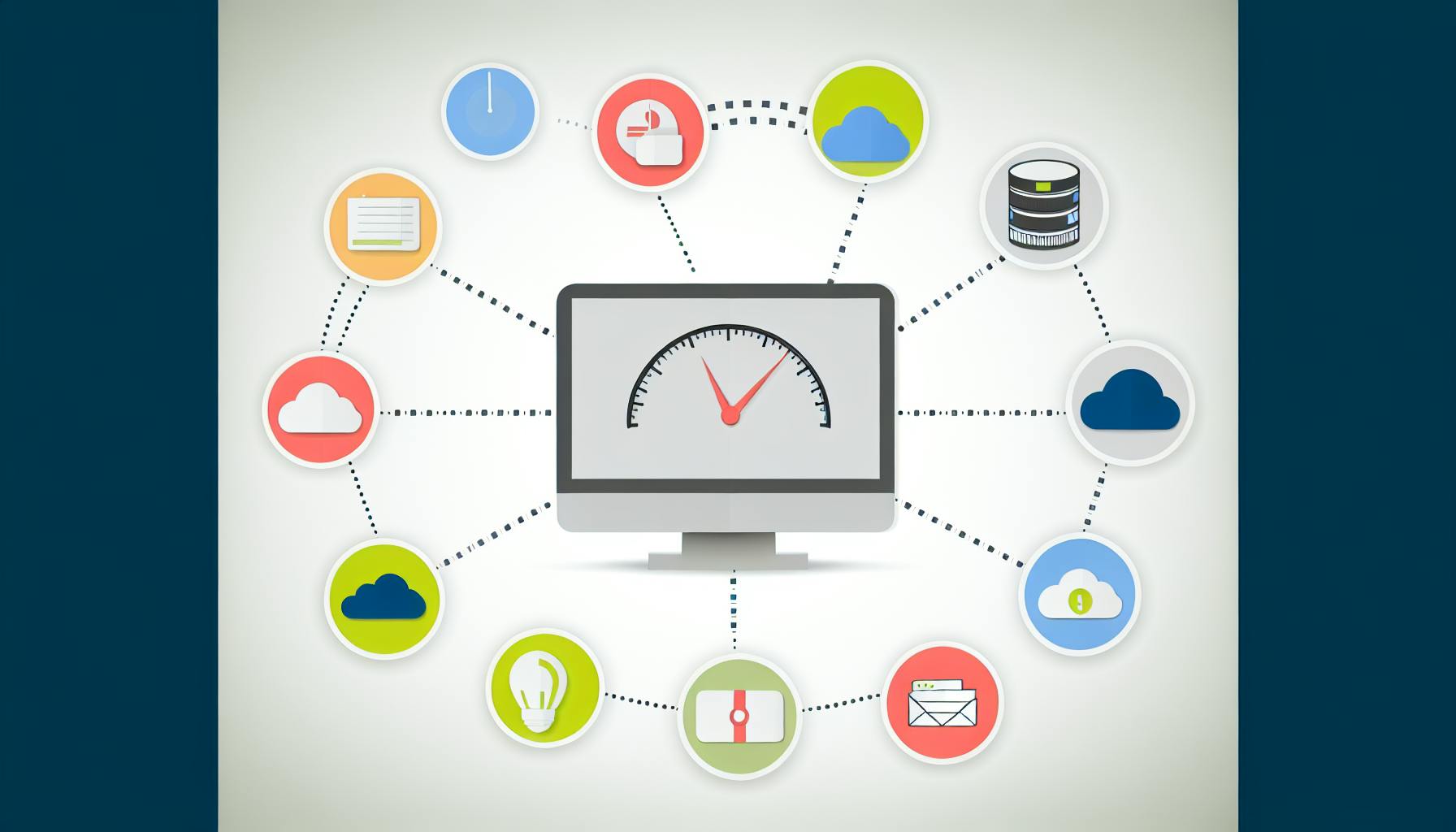Anomaly detection tools are crucial for identifying unusual activities in your data, offering a layer of protection against potential threats and operational issues. These tools analyze patterns to spot abnormalities, such as security breaches, operational glitches, or fraudulent activities, helping businesses react swiftly to mitigate risks. Here's a quick overview:
- Anomaly Detection Explained: Tools that identify unusual data patterns, acting as a safeguard for your business.
- Types of Anomalies: Understanding point, contextual, and collective anomalies to choose the right detection approach.
- Importance: Key in preventing data breaches, ensuring system reliability, and meeting compliance requirements.
- Techniques and Algorithms: From supervised to unsupervised learning, and popular algorithms like LOF, Isolation Forest, and neural networks.
- Challenges: Establishing reliable baselines, minimizing false positives, and integrating with existing systems.
- Implementation: Considerations for selecting and integrating the right tool for your needs.
- Applications: Wide-ranging uses from safeguarding financial transactions to enhancing healthcare outcomes and boosting manufacturing productivity.
- The Future: Advances in machine learning models and predictive capabilities to offer more sophisticated and proactive anomaly detection.
By employing anomaly detection tools, businesses can significantly enhance their operational efficiency, security posture, and compliance standing, staying ahead of potential threats.
What is Anomaly Detection?
Anomaly detection is all about spotting the odd ones out in your data. Think of it as a security guard for your data, looking out for anything unusual that might mean trouble, like a cyber attack or a system going haywire.
Here are a few examples of what these tools can catch:
- Big changes in how many people visit a website
- Weird patterns in how users log in
- Computers or systems using more resources than they should
- Odd transactions or money moving in strange ways
Catching these issues fast helps businesses fix them before they turn into bigger headaches. Plus, it's part of keeping things above board and protecting sensitive information.
Types of Anomalies
Anomalies come in different flavors, and knowing these can help pick the right tool for the job:
Point Anomalies
This is when one piece of data is way off from what you expect. Like if someone logs in from a country they've never visited before.
Contextual Anomalies
Something might look weird only in certain situations. High sales on Black Friday are normal, but on a random Tuesday? Not so much.
Collective Anomalies
When a bunch of data points look fine on their own but weird together. Think of it as a bunch of failed logins from different users that might signal hackers trying to break in.
Knowing the type of anomaly helps figure out the best way to catch it. Simple oddities might just need a basic check-up, but weirder patterns could require some fancy math or machine learning to spot.## The Importance of Anomaly Detection
In Preventing Data Breaches and System Failures
Anomaly detection tools are really important because they keep an eye on your data and systems all the time. They learn what's normal and quickly spot anything that doesn't fit. This is crucial for stopping security problems and keeping systems running smoothly.
Here are some ways these tools help:
- Spotting when someone shouldn't be getting in: If there's a weird pattern in how people log in, like too many wrong passwords or logins from strange places, it could mean someone's trying to break in. Catching this early means you can stop them.
- Noticing when something's using too much stuff: If your computer or system starts using a lot more internet, space, or other resources out of the blue, it might be a sign of a virus or someone stealing information. Finding this fast helps stop the damage.
- Finding mistakes and things slowing down: When apps or systems don't work like they usually do, it could lead to big problems, like everything stopping. These tools help find those issues before they get worse.
- Making sure you're following the rules: For businesses that have to keep data safe and private, these tools can catch when someone's trying to peek at or change information they shouldn't. This helps the business stay in line with laws.
By always watching for odd things, anomaly detection tools give businesses a better chance to fix problems quickly and keep risks low.
For Compliance and Regulatory Requirements
These tools also help businesses meet important rules and laws about keeping data safe. This is especially true for companies in areas like banking, healthcare, and online shopping, where protecting information is a big deal.
Some examples include:
- SOC 2: This is about making sure only the right people can get to important information. Anomaly detection can help by noticing if someone's trying to get in who shouldn't.
- NIST Cybersecurity Framework: This helps businesses be ready for and deal with security problems. Anomaly detection is part of finding those problems fast.
- GDPR: This is a big deal in Europe for protecting personal information. These tools can help by spotting if someone's messing with that info.
- PCI DSS: If you're a business that takes card payments, you need to protect that data. Anomaly detection can alert you if something's not right.
- HIPAA: For healthcare, keeping patient information safe is super important. These tools help by catching unusual access attempts.
With these tools, businesses can keep an eye out for anything unusual and stay on top of keeping data safe and following the rules.
Anomaly Detection Techniques
Supervised vs. Unsupervised Anomaly Detection
When we talk about finding the odd bits in our data, we can do it in two main ways: supervised and unsupervised. Here’s a simple breakdown of what they mean:
| Technique | Pros | Cons |
|---|---|---|
| Supervised | - Really good at spotting the types of weirdness we know about - Can be tweaked for specific needs |
- Needs a bunch of examples to learn from - Might miss new, unexpected weirdness |
| Unsupervised | - Great for finding new kinds of weirdness - Doesn’t need examples to learn from |
- Might mistake normal for weird sometimes - Trickier to make it do exactly what we want |
Supervised methods learn from examples. We show them what normal looks like and what the odd stuff looks like. This way, they get really good at spotting these known oddities. But, if something new and strange pops up that they haven’t seen before, they might not catch it.
Unsupervised methods are like explorers. They don’t need a map (examples) to find weirdness. They just look at everything and notice what sticks out as unusual. This is cool because they can find new kinds of weirdness. But sometimes, they might get a bit overexcited and think something is strange when it’s actually not.
Popular Anomaly Detection Algorithms
There are a few main ways to spot weirdness in our data:
Density-based algorithms are like looking for someone standing alone at a party. They find data points that are off by themselves, away from the crowd. Examples include Local Outlier Factor (LOF) and Isolation Forest.
Clustering algorithms are like grouping people at that party into circles of friends. If someone is standing too far from any group, they might be considered odd. K-means clustering is one way to do this.
Bayesian networks are a bit like detective work, figuring out how things usually relate to each other. When something doesn’t fit the pattern, it might be a clue that something’s up.
Neural networks, especially ones good at following patterns over time like LSTMs, are great for when we want to predict what should happen next based on past data. If the actual data doesn’t match up with the prediction, it might be a sign of something weird.
Choosing the right way to find weirdness depends on what kind of data you have, what you’re trying to do, and how much computer power you’ve got. For simple stuff, density-based methods like LOF are quick and easy. But for more complex patterns, especially with time series data, neural networks might be the way to go.
Challenges in Anomaly Detection
Anomaly detection is super helpful for spotting issues, but getting it right can be tricky. Let's talk about some common hurdles.
Establishing Reliable Baselines
First off, figuring out what's "normal" can be tough. Anomaly detection needs a good amount of past data to know what usual patterns look like. But if you don't have enough good-quality data, or if what's normal keeps changing, it can throw the whole system off.
Here are some things that make this hard:
- Systems that keep changing
- Not enough old data to learn from
- Data that's messy or full of mistakes
To get around this, you need to spend time gathering and cleaning up data so your anomaly detection can know what to look for.
Tuning to Minimize False Positives
Another issue is avoiding too many false alarms. If your system is too sensitive, it'll flag normal stuff as weird, which isn't helpful.
To fine-tune your system, consider:
- Adjusting how strict your rules are
- Picking the right method for your type of data
- Combining different approaches to get a clearer picture
- Focusing on the really important weird things that you need to know about
Integration with Existing Systems
Fitting anomaly detection into what you already have can also be a challenge. You need to plan carefully so it works with:
- How you keep an eye on things and send out alerts
- Your systems for handling issues when they pop up
- Tools for making reports and checking on things
You want to make sure the new system fits into your current setup smoothly so you can act on the alerts it gives you.
Other Challenges
There are a few more things to watch out for, like:
- Deciding exactly what counts as weird
- Not having examples of known weird things to learn from
- The cost and effort of setting things up
- Having to check the system's alerts by hand
- Keeping the system working well over time as things change
Even though anomaly detection can really help find problems, it's important to know it takes some work to get it right.
Implementing Anomaly Detection Tools
Choosing the Right Tool
When you're picking a tool to help spot when something's not right in your data, think about a few things:
- Data types: What kind of data are you dealing with? If it's complex or follows a pattern over time, tools that use neural networks might be best.
- Infrastructure: Do you want to handle everything on your own computers, or are you okay with using services on the internet? Each has its own benefits.
- Use cases: What do you need the tool for? Catching fraud, stopping hackers, or making sure your systems are running right? Make sure the tool you choose is good at what you need.
- Ease of integration: Can the tool easily work with what you already have? It's important that it can fit into your current system without too much trouble.
Try out different tools to see what works best for you. Some, like Eyer.ai, let you test them for free.
Integration into Existing Systems
Getting these tools to work well with what you already have takes some planning. Here's what to think about:
- Data pipelines are needed to get your data ready and send it to the tool. Think about how you'll do this and what it might cost.
- Alerting platforms like PagerDuty can let the right people know as soon as something odd is spotted, so they can look into it right away.
- Dashboards help you see what's going on with your data and any alerts in one place.
- Response workflows are your plans for what to do when different kinds of weird stuff are found. Having a plan helps you deal with issues faster.
Tools like Eyer.ai are made to work easily with many systems, making it simpler to start using them.
The goal is to make sure you can see and react to issues quickly, reducing the chance of big problems.
sbb-itb-9890dba
Real-World Applications
Anomaly detection tools are super useful in many areas like finance, healthcare, manufacturing, and keeping computers safe. They help organizations run smoother, save money, and be safer by always keeping an eye on data and systems.
Safeguarding Financial Transactions
Banks and other places where money is handled use these tools a lot. They help find and stop fraud and cyberattacks. Here’s how:
- Fraud detection - These tools can spot when a transaction looks fishy, like if someone might be using a stolen credit card.
- Anti-money laundering - They can also find weird patterns in how money is moved around that might show criminal activity.
- Market surveillance - They help catch strange trading activities that could be unfair, like insider trading.
- Risk modeling - They detect changes in risk, like if a loan is becoming riskier.
Enhancing Healthcare Outcomes
In healthcare, these tools help in several ways:
- Clinical surveillance - They can alert doctors to unusual symptoms or changes in a patient’s health.
- Medical claims analysis - They find strange patterns in billing that might mean fraud.
- Patient monitoring - They help catch early signs of trouble in patient health metrics.
- Epidemic tracking - They can help spot disease outbreaks sooner by noticing unusual symptoms.
Boosting Manufacturing Productivity
In manufacturing, these tools help by:
- Predictive maintenance - Spotting signs that a machine might need fixing soon.
- Quality control - Finding defects by noticing when something’s not as it should be.
- Operational optimization - Identifying slow-downs in the manufacturing process.
- Supply chain monitoring - Catching delays in shipments or when inventory is low.
Hardening Cyber Defenses
For keeping computer systems safe, these tools are key for:
- Intrusion detection - Spotting signs of hacking, like weird network traffic or unusual login attempts.
- Insider threat detection - Finding when someone inside the company accesses data they shouldn’t.
- Malware detection - Noticing when a computer might be infected based on odd behavior.
- Policy violation detection - Catching when employees use apps or visit websites they’re not supposed to.
By always looking for things that don’t look right, anomaly detection tools give companies an extra layer of safety and help them stay on top of their game.
The Future of Anomaly Detection
As we keep collecting more and more data, being able to spot when something unusual happens is becoming crucial. This helps us see hidden problems or chances that we might miss otherwise. Here's a look at what's coming up in the world of spotting these odd bits of data:
More Sophisticated Machine Learning Models
Newer ways of using machine learning, like generative adversarial networks (GANs) and self-supervised learning, are getting better at finding the really sneaky anomalies that older methods might not catch. These new techniques will help us:
- Spot dangers that are trying to look normal
- Keep up with changes over time better
- Use less labeled data to learn about new datasets
Businesses will use these advanced models to better protect themselves against complex threats.
Real-Time Predictive Anomaly Detection
Just finding anomalies after they happen isn't enough anymore, especially as data keeps coming in faster. The next big thing is being able to predict anomalies before they even happen by looking for early warning signs. This could help us:
- Stop attacks before they get far
- Fix systems before they break down
- Make quick adjustments in business operations
Companies will start using predictive anomaly detection in their daily decision-making processes for a quicker response.
Holistic Multidimensional Analysis
Looking at anomalies one by one doesn't give us the full picture. By checking them against multiple sources of data, we can understand the bigger story. Businesses will start to connect the dots between anomaly detection and other data like logs and metrics for:
- Fewer false alarms
- Clearer signals for when to take action
- Better ways to investigate problems
This broader approach will make finding and fixing issues more precise and faster.
In the future, anomaly detection will use more complex machine learning to find hidden threats, predict problems before they happen, and take a wider view to understand data better. This will help businesses grow and manage risks more effectively.
Conclusion
Anomaly detection tools are really important for keeping an eye on our computer systems and data. They help us catch strange behavior that could be a sign of someone trying to break into our systems or cause problems. As hackers get smarter, these tools help us find and stop threats early on.
Here’s why anomaly detection is so useful:
- Spotting problems early: These tools learn what normal activity looks like so they can spot anything unusual. This means we can deal with threats before they cause big issues.
- Lowering risks: By quickly spotting odd login attempts, weird network traffic, or unexpected use of resources, we make our systems safer.
- Making systems tougher: Being able to quickly find and fix odd behaviors helps our systems bounce back faster. This means less downtime.
- Watching all the time: Unlike just checking now and then, anomaly detection keeps an eye on things 24/7. This way, we can catch threats right as they happen.
- Staying within the rules: These tools also make sure we’re doing what we’re supposed to do to protect our data and systems, following laws and guidelines.
With more data and more complex systems, it’s really important to use anomaly detection. It helps us keep our systems safe and sound, even as the risks grow.



